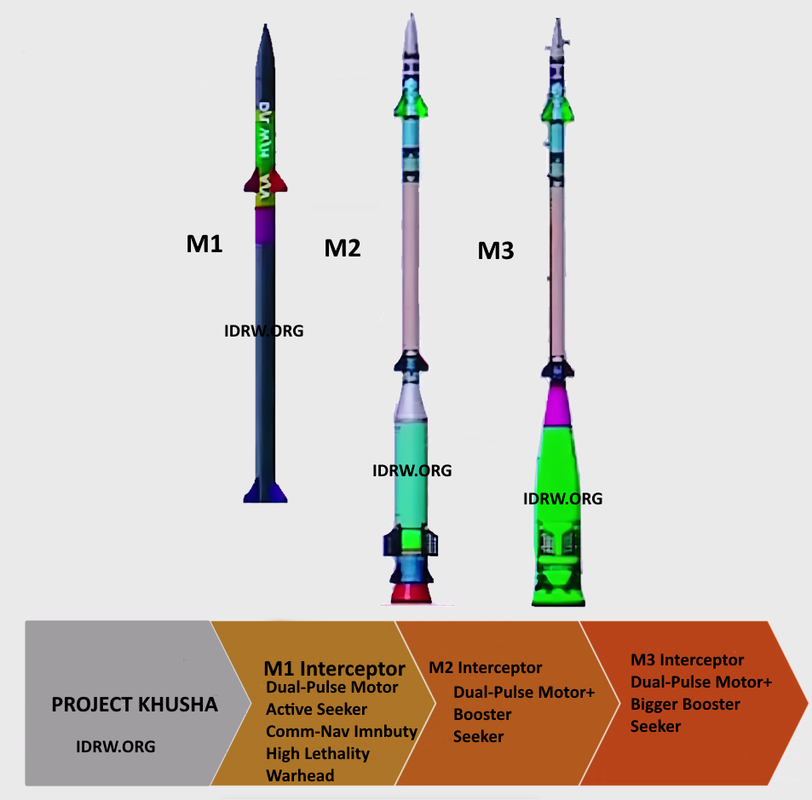SOURCE: RAUNAK KUNDE / NEWS BEAT / IDRW.ORG


The Defence Research and Development Organisation (DRDO) of India has confirmed a significant advancement in its ambitious Project Kusha, revealing that the M3 interceptor missile, a key component of the indigenous long-range air defence system, will have a range of 400 kilometers—matching the capabilities of the Russian S-400’s 40N6E missile, the longest-range missile in its arsenal.
This marks an upgrade from the previously stated range of 350km for the M3, enabling it to engage large, high-value targets such as Airborne Warning and Control Systems (AWACS), in-flight refuellers, and transport aircraft operating deep within enemy airspace. Alongside the M3, Project Kusha includes the M1 and M2 interceptors with ranges of 150km and 250km, respectively, positioning India to develop a robust, layered air defence network to counter growing regional threats.
Project Kusha, launched under India’s Aatmanirbhar Bharat (Self-Reliant India) initiative, aims to deliver an indigenous long-range surface-to-air missile (SAM) system by 2028–29, complementing and potentially surpassing the capabilities of the Russian-supplied S-400 systems in India’s arsenal. Designed to counter a wide range of aerial threats—including fighter jets, ballistic missiles, cruise missiles, and drones—the Kusha system is being developed by the DRDO’s Hyderabad-based laboratories, with production support from private industry partners like Larsen & Toubro and Bharat Electronics Limited (BEL).
This range aligns the M3 with the S-400’s 40N6E missile, which is renowned for its ability to engage targets at extreme distances and altitudes up to 30km. The M3’s extended reach, an increase of nearly 50km over the earlier projected 350km, enhances its capability to neutralize high-value assets like AWACS, refuellers, and transport aircraft, which typically operate deep within enemy territory to avoid shorter-range threats.
M1, M2, and M3: A Layered Defence Approach
Project Kusha’s three-tiered missile system—M1, M2, and M3—provides a comprehensive air defence architecture tailored to diverse threats at varying ranges and altitudes:
- M1 Interceptor (150km Range): Designed for short-to-medium-range engagements, the M1 is optimized to counter tactical threats such as fighter jets, drones, and low-flying cruise missiles. With a range comparable to the S-400’s 48N6 missile, the M1 will provide point defence for critical assets like military bases and urban centers.
- M2 Interceptor (250km Range): The M2 bridges the gap between short- and long-range threats, capable of engaging aircraft, missiles, and drones at extended distances. Its versatility makes it suitable for area defence, protecting larger regions or strategic installations.
- M3 Interceptor (400km Range): The flagship of Project Kusha, the M3 is engineered to tackle high-value, long-range targets, including AWACS, refuellers, and transport aircraft. Its 400km range and high-altitude engagement capability make it a strategic asset for denying adversaries air superiority deep within their airspace.
The M3’s ability to engage targets at 400km, as confirmed by DRDO officials during a recent media briefing, positions it as a direct competitor to the S-400’s 40N6E missile, which has a similar range and is designed to target large, low-maneuverability platforms. This capability is critical in the context of India’s strategic rivalry with China, which operates advanced AWACS like the KJ-2000 and Y-20U refuellers, and Pakistan, which relies on assets like the Saab 2000 Erieye AWACS, as demonstrated during the May 2025 India-Pakistan clashes.
The development of the M3 interceptor with a 400km range enhances India’s ability to project air defence dominance in the Indo-Pacific region, particularly against China’s People’s Liberation Army Air Force (PLAAF) and Pakistan Air Force (PAF). The 2025 Operation Sindoor, where the IAF targeted PAF bases like Murid and Bholari, highlighted the importance of neutralizing high-value assets like AWACS to disrupt enemy command and control. The M3’s extended range ensures that such targets, often positioned deep within enemy territory to avoid shorter-range SAMs, can be engaged effectively.
The M3’s capabilities also address the growing threat of ballistic and cruise missiles. With a high-altitude intercept capability, the M3 can counter tactical ballistic missiles, complementing India’s Ballistic Missile Defence (BMD) system, which includes the Prithvi Air Defence (PAD) and Advanced Air Defence (AAD) interceptors. The Kusha system’s integration with advanced radars, such as the indigenous Long-Range Tracking Radar (LRTR) with a detection range exceeding 1,500km, will provide a seamless detect-to-engage cycle, rivaling the S-400’s architecture.
The M3’s 400km range is supported by advancements in propulsion, guidance, and sensor technologies. The missile is expected to feature a dual-pulse solid rocket motor for extended range and a hit-to-kill warhead for precision engagements. Its active electronically scanned array (AESA) radar seeker and network-centric integration enable it to operate in contested environments with heavy electronic warfare. The DRDO’s focus on indigenous technologies, including gallium nitride-based radar modules and advanced thermal management systems, ensures cost-effectiveness and scalability.
NOTE: Article cannot be reproduced without written permission of idrw.org in any form even for YouTube Videos to avoid Copy right strikes. Websites doing illegal reproductions will get DMCA and Legal Notices.